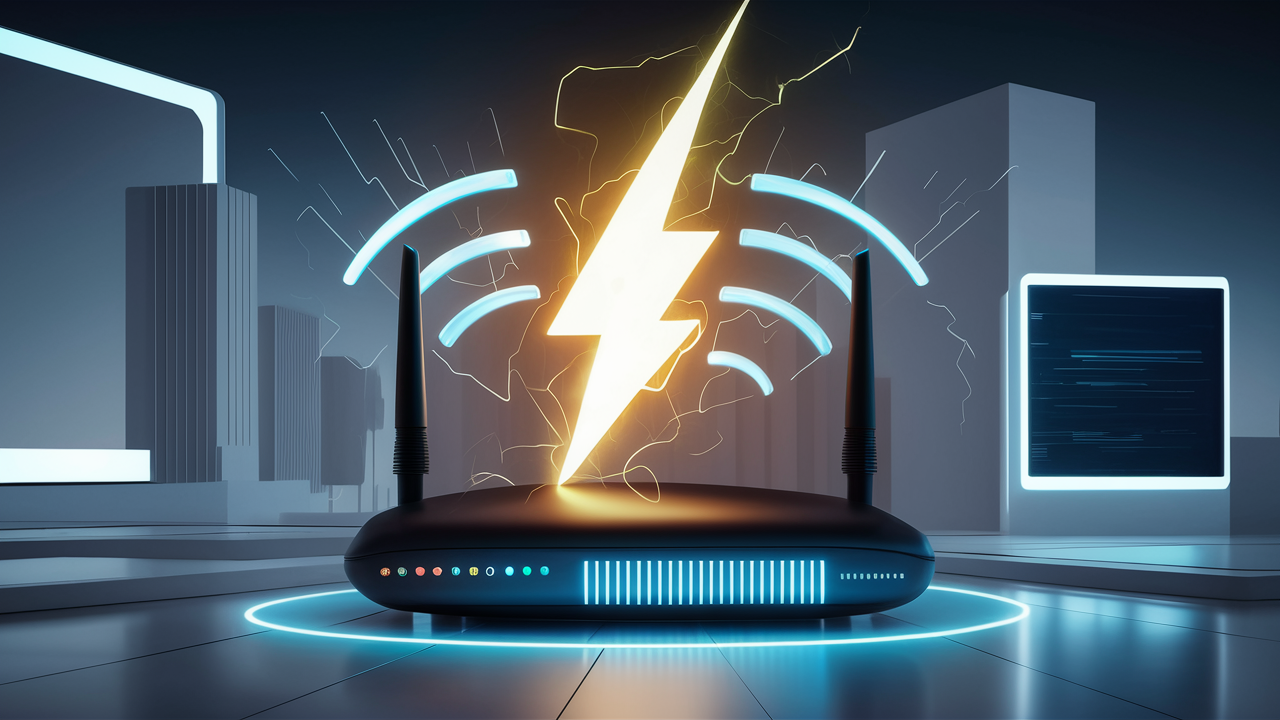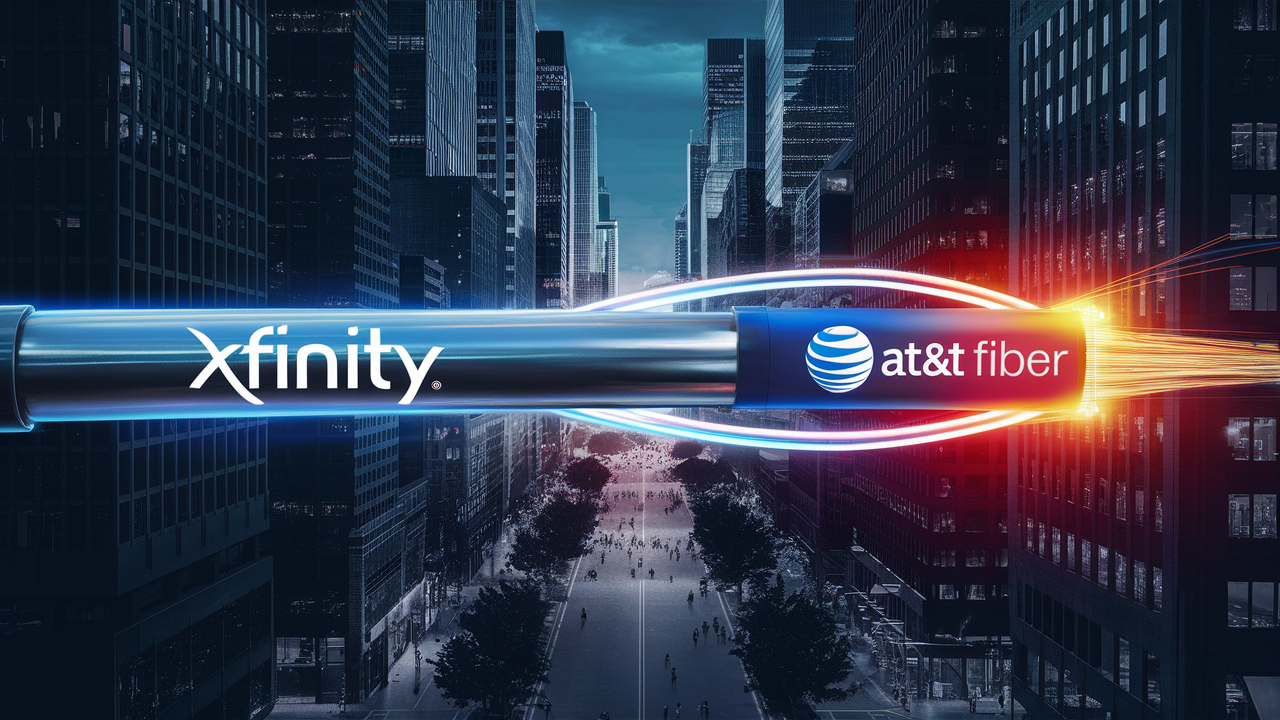How to increase WiFi speed?

Struggling with slow internet speeds? This comprehensive guide reveals exactly how to increase WiFi speed, covering everything from simple router placement tweaks to advanced network optimization strategies. Discover actionable steps and expert insights to finally achieve the fast, reliable connection you deserve.
Optimize Your Router's Location
The physical placement of your WiFi router is one of the most significant, yet often overlooked, factors affecting your internet speed and coverage. Even the most powerful router will struggle to deliver optimal performance if it's not positioned correctly. Understanding how radio waves travel and the common obstructions they encounter is key to unlocking better WiFi performance.
Centralize Your Router
The ideal location for your WiFi router is as close to the center of your home or office as possible. This ensures that the signal can radiate outwards evenly in all directions, reaching more devices with a consistent strength. Placing it in a corner, near an exterior wall, or in a basement will inevitably lead to weaker signals in other parts of your space.
Elevate Your Router
Radio waves tend to travel downwards. By placing your router on a high shelf, atop a cabinet, or even mounting it on a wall, you can improve signal distribution throughout your living or working area. Avoid placing it on the floor, as this can significantly impede signal strength.
Avoid Obstructions and Interference
Several common household items can act as barriers or sources of interference for your WiFi signal. Thick walls (especially those made of brick, concrete, or metal), large appliances (like microwaves, refrigerators, and washing machines), and even water (fish tanks, plumbing) can absorb or reflect WiFi signals, weakening them considerably. Electronic devices that operate on similar radio frequencies, such as cordless phones, Bluetooth devices, and even some baby monitors, can also cause interference. Try to keep your router away from these potential disruptors.
Common Signal Blockers and Interferers:
- Thick walls (brick, concrete, metal studs)
- Large appliances (microwaves, refrigerators)
- Water (aquariums, plumbing)
- Mirrors and metal furniture
- Other electronic devices (cordless phones, Bluetooth speakers)
Minimize Other WiFi Networks
If you live in a densely populated area like an apartment building or a townhouse complex, you're likely surrounded by numerous other WiFi networks. These networks operate on the same frequency bands (2.4GHz and 5GHz) and can interfere with each other. While you can't control your neighbors' networks, strategic router placement can help mitigate some of this interference. For instance, if your router is positioned further away from shared walls or if you can utilize less congested channels (discussed later), you might see an improvement.
Test and Adjust
Don't be afraid to experiment with different locations. After moving your router, test your WiFi speed and signal strength in various rooms using a speed test app or your device's WiFi indicator. Make small adjustments and re-test until you find the optimal spot that provides the best balance of speed and coverage throughout your entire space.
Tweak Your Router Settings
Your WiFi router is a sophisticated piece of technology, and its default settings aren't always optimized for peak performance. By delving into your router's administrative interface, you can make several adjustments that can significantly boost your WiFi speed and improve its stability. Accessing these settings typically involves typing your router's IP address into a web browser.
Update Your Router's Firmware
Router manufacturers regularly release firmware updates that fix bugs, improve performance, and patch security vulnerabilities. Outdated firmware can be a major bottleneck. Check your router's administration panel for a firmware update option and install the latest version. This is a simple yet crucial step for maintaining optimal performance and security.
How to Update Firmware:
- Open a web browser and enter your router's IP address (commonly 192.168.1.1 or 192.168.0.1).
- Log in using your router's username and password.
- Navigate to the 'Administration,' 'System Tools,' or 'Firmware Update' section.
- Check for updates and follow the on-screen instructions to download and install.
- Restart your router after the update is complete.
Change the WiFi Channel
WiFi networks operate on specific channels within the 2.4GHz and 5GHz frequency bands. If too many networks in your area are using the same channel, it can lead to congestion and slower speeds. The 2.4GHz band is more prone to interference and congestion because it has fewer channels and is used by many other devices.
Understanding WiFi Channels:
- 2.4GHz Band: This band offers a longer range but is slower and more susceptible to interference. It has 11-14 channels, but only channels 1, 6, and 11 are truly non-overlapping in North America.
- 5GHz Band: This band offers faster speeds and less interference but has a shorter range. It has many more channels, providing more options for less congested usage.
Most routers are set to 'Auto' channel selection, which can sometimes pick a congested channel. You can manually scan for the least congested channel. Many WiFi analyzer apps for smartphones can help you identify which channels are most crowded in your vicinity. Once identified, log into your router's settings and manually select a less crowded channel, preferably 1, 6, or 11 for the 2.4GHz band, or an available channel in the 5GHz band.
Adjust the WiFi Band
Modern routers are dual-band, meaning they broadcast both 2.4GHz and 5GHz networks. The 2.4GHz band is better for range and compatibility with older devices, while the 5GHz band offers significantly faster speeds and less interference for devices that support it and are within a reasonable range of the router.
If your router broadcasts separate SSIDs (network names) for each band (e.g., "MyWiFi_2.4GHz" and "MyWiFi_5GHz"), connect devices that are closer to the router and capable of 5GHz to the 5GHz network for the best speeds. For devices further away or older devices, the 2.4GHz band might be more reliable, albeit slower.
Optimize the WiFi Channel Width
Channel width refers to the amount of spectrum your WiFi signal uses. Wider channels allow for more data to be transmitted simultaneously, leading to higher speeds. For the 2.4GHz band, common widths are 20MHz and 40MHz. For the 5GHz band, you might see options like 20MHz, 40MHz, 80MHz, and even 160MHz on newer routers.
While wider channels generally mean faster speeds, they can also increase the risk of interference, especially in crowded environments. For the 2.4GHz band, sticking to 20MHz is often recommended to avoid interference. For the 5GHz band, using the widest available channel (e.g., 80MHz or 160MHz) can provide a significant speed boost, provided there isn't too much interference.
Enable Quality of Service (QoS)
Quality of Service (QoS) allows you to prioritize certain types of traffic or specific devices on your network. If you experience buffering during video calls when someone else is downloading large files, QoS can help. By assigning higher priority to your video conferencing or streaming devices, you can ensure they get the bandwidth they need, even when the network is busy.
How to Configure QoS:
- Log into your router's administration interface.
- Find the QoS settings (often under 'Advanced Settings' or 'Traffic Management').
- Enable QoS.
- You can typically prioritize by device (MAC address or IP address) or by application type (e.g., streaming, gaming, VoIP).
- Assign a higher priority to your most critical devices or applications.
- Save your settings.
Change Your WiFi Password and Security Type
An unsecured or weakly secured WiFi network can be accessed by unauthorized users, consuming your bandwidth and slowing down your connection. Ensure your network uses WPA2 or WPA3 encryption and has a strong, unique password. Regularly changing your password can also help prevent unauthorized access.
Consider Router Channel Bonding (Advanced)
Some routers support channel bonding, a technology that combines multiple WiFi channels to create a wider, faster connection. This is often an automatic setting when you select a wider channel width, but it's worth checking if your router has specific options related to it. For example, on the 5GHz band, bonding two 40MHz channels creates an 80MHz channel.
Upgrade Your WiFi Hardware
Sometimes, the bottleneck isn't just placement or settings; it's the hardware itself. If your router is several years old, it might not be capable of supporting the latest WiFi standards or the speeds your internet plan provides. Similarly, older devices connecting to your network might not be able to take advantage of newer, faster WiFi technologies.
Replace Your Old Router
WiFi technology has evolved rapidly. Routers adhering to older standards like 802.11n (WiFi 4) or even early 802.11ac (WiFi 5) might struggle with modern demands. Upgrading to a router that supports the latest standards, such as WiFi 6 (802.11ax) or WiFi 6E, can provide a significant boost in speed, capacity, and efficiency, especially in environments with many connected devices.
WiFi Standards Comparison (2025 Outlook):
| Standard | Year Introduced | Theoretical Max Speed | Key Features | Best For |
|---|---|---|---|---|
| 802.11ac (WiFi 5) | 2013 | Up to 3.5 Gbps (router dependent) | MU-MIMO, Dual-band (2.4GHz & 5GHz) | General home use, streaming, older devices |
| 802.11ax (WiFi 6) | 2019 | Up to 9.6 Gbps | OFDMA, MU-MIMO (uplink & downlink), Target Wake Time, 1024-QAM | High-density environments, many devices, demanding applications |
| 802.11be (WiFi 7) | Expected 2024/2025 | Up to 46 Gbps | Multi-Link Operation (MLO), 320MHz channels, 4096-QAM | Future-proofing, ultra-high-speed applications, AR/VR |
When choosing a new router, consider your internet speed plan. If you have a gigabit internet connection, an older router will be a bottleneck. Look for routers that explicitly state support for your internet speed and the latest WiFi standards. Features like MU-MIMO (Multi-User, Multiple Input, Multiple Output) and OFDMA (Orthogonal Frequency Division Multiple Access) are crucial for handling multiple devices efficiently, which is increasingly important in 2025.
Consider a Mesh WiFi System
For larger homes or buildings with dead zones, a single router might not provide adequate coverage. A mesh WiFi system consists of a main router and one or more satellite nodes that work together to create a single, seamless WiFi network. This eliminates dead spots and ensures consistent speeds throughout your entire property.
Mesh WiFi vs. Traditional Routers:
- Coverage: Mesh systems offer superior coverage for larger areas.
- Seamless Roaming: Devices automatically connect to the strongest node without interruption.
- Ease of Use: Typically managed through a user-friendly mobile app.
- Cost: Can be more expensive than a single high-end router.
If you're experiencing weak signals in certain rooms, a mesh system is a highly effective solution. Many mesh systems also support the latest WiFi standards, offering both improved coverage and speed.
Upgrade Your WiFi Adapter (for Laptops and Desktops)
Even with a powerful new router, older laptops, desktops, or other devices with outdated WiFi adapters will be limited by their own hardware. If you have devices that consistently show slower speeds than others, consider upgrading their WiFi adapter. USB WiFi adapters are a relatively inexpensive way to boost performance on older computers.
Choosing a WiFi Adapter:
- Ensure the adapter supports the same WiFi standards as your router (e.g., WiFi 6).
- Check for dual-band support (2.4GHz and 5GHz).
- Look for adapters with external antennas for better reception.
- Read reviews to gauge real-world performance.
Check Your Ethernet Cables
If you're using wired connections, ensure you're using high-quality Ethernet cables. Older Cat 5 cables can be a bottleneck for speeds above 100 Mbps. For gigabit speeds and beyond, Cat 5e or Cat 6 cables are recommended. Damaged or frayed cables can also degrade performance.
Manage Your WiFi Network Effectively
Beyond hardware and settings, how you use and manage your WiFi network can have a significant impact on its speed and reliability. Implementing good network hygiene and understanding device usage patterns can lead to a smoother online experience.
Limit the Number of Connected Devices
Every device connected to your WiFi network consumes bandwidth. While modern routers are designed to handle multiple devices, an excessive number can still lead to congestion and slower speeds for everyone. Regularly review the devices connected to your network and disconnect any that are not in use or are consuming excessive bandwidth unnecessarily.
Strategies for Managing Devices:
- Disable Auto-Connect: Prevent devices from automatically connecting to your WiFi when they are in range.
- Guest Network: Use your router's guest network feature for visitors. This isolates their devices from your main network and prevents them from impacting your primary connection's performance.
- Parental Controls: If your router offers parental controls, use them to limit internet access for certain devices during specific times, reducing overall network load.
Prioritize Bandwidth-Intensive Activities
Identify which devices and applications are consuming the most bandwidth. If you're experiencing slow speeds during peak usage times, consider scheduling large downloads or updates for off-peak hours. For activities like online gaming or video conferencing, ensure these devices have a strong connection and, if possible, are prioritized using QoS settings.
Secure Your Network
As mentioned earlier, an unsecured network is an open invitation for bandwidth theft. Beyond changing your password, regularly check your router's connected devices list to ensure no unauthorized devices are present. If you see unfamiliar devices, change your password immediately and consider enabling MAC address filtering (though this is less critical than a strong password).
Reboot Your Router Regularly
Like any electronic device, routers can benefit from a periodic reboot. This clears temporary memory, resolves minor glitches, and can often restore lost performance. Aim to reboot your router at least once a month, or more frequently if you notice performance degradation.
Recommended Reboot Schedule:
- Monthly: A good baseline for most home users.
- Weekly: Consider if you have many devices or experience frequent issues.
- On Demand: Reboot whenever you notice a significant drop in speed or connectivity.
Use Wired Connections When Possible
For stationary devices that require the fastest and most stable connection, such as desktop computers, smart TVs, or gaming consoles, using an Ethernet cable is always preferable to WiFi. Wired connections bypass many of the potential issues that affect wireless performance, including interference and signal degradation.
Consider a WiFi Extender or Repeater (with Caution)
While mesh systems are generally superior, WiFi extenders or repeaters can be a more budget-friendly option for extending coverage to a specific area. However, these devices often halve the available bandwidth and can sometimes create more problems than they solve if not configured correctly. They essentially rebroadcast the existing signal, which can lead to slower speeds. If you opt for one, place it halfway between your router and the dead zone, and ensure it's compatible with your router's WiFi standard.
Troubleshoot Your Internet Service Provider (ISP)
Sometimes, the problem isn't with your internal WiFi network but with the internet service coming into your home. Your ISP plays a crucial role in your overall internet speed, and several issues on their end can affect your performance.
Test Your Internet Speed Directly from the Modem
To determine if the issue lies with your ISP or your WiFi network, connect a computer directly to your modem using an Ethernet cable and run a speed test. If the speeds are significantly lower than what you're paying for, the problem is likely with your ISP or the modem itself. If the speeds are as expected, the issue is almost certainly with your WiFi setup.
Check Your Internet Plan Speeds
Are you getting the speeds you're paying for? Log into your ISP account or check your latest bill to confirm your plan's advertised speeds. It's common for advertised speeds to be "up to" a certain number, and real-world speeds can vary. However, if your direct modem tests are consistently far below the advertised speeds, it's time to contact your ISP.
Inspect Your Modem
Your modem is the gateway to the internet. Ensure it's not overheating, that its lights indicate a stable connection, and that it's compatible with your ISP's service. Older modems can also be a bottleneck. Your ISP might offer modem upgrades, or you may need to purchase a compatible one yourself.
Modem Lights Explained (General):
- Power: Indicates the modem is receiving power.
- Receive/Downstream: Shows a connection to the ISP's network for incoming data.
- Send/Upstream: Shows a connection to the ISP's network for outgoing data.
- Online/Internet: Indicates a stable connection to the internet.
If any of these lights are blinking erratically or are off when they should be solid, it suggests a connection issue.
Contact Your ISP
If your direct modem tests reveal slow speeds, or if you suspect an issue with your service, contact your ISP. They can check for outages in your area, diagnose problems with their equipment or lines, and potentially send a technician to your home. Be prepared to provide them with your modem model, speed test results, and details about your setup.
Consider a Higher Speed Plan
If your current internet plan simply doesn't meet your needs (e.g., you have many devices, stream high-definition content, or engage in online gaming), you might need to upgrade your plan. For 2025, consider plans that offer at least 300-500 Mbps for a household with multiple users and devices. Gigabit plans (1000 Mbps) are becoming more common and affordable for power users.
Advanced WiFi Speed Boosters
For those who have tried the basic steps and are still looking for that extra edge, several advanced techniques and technologies can help squeeze more performance out of your WiFi network.
Utilize the 5GHz and 6GHz Bands (WiFi 6E)
As discussed, the 5GHz band offers significantly faster speeds and less interference than 2.4GHz. If your router and devices support it, always prioritize the 5GHz band for performance-critical tasks. For those with the latest routers and devices, WiFi 6E introduces the 6GHz band, which is even less congested and offers even higher speeds, though with a shorter range.
Enable 160MHz Channels (on 5GHz/6GHz)
If your router supports 160MHz channel widths on the 5GHz or 6GHz bands, and your environment allows for it without excessive interference, enabling this can double the potential throughput compared to 80MHz channels. This is a significant speed booster for compatible devices.
Smart Connect / Band Steering
Many modern routers feature a "Smart Connect" or "Band Steering" function. This technology automatically assigns devices to the optimal WiFi band (2.4GHz or 5GHz/6GHz) based on their capabilities and signal strength. While convenient, sometimes manually assigning devices to specific bands can yield better results, especially if the automatic assignment isn't performing as expected.
Powerline Adapters
Powerline adapters use your home's electrical wiring to transmit network data. They can be a useful alternative to WiFi extenders for getting a wired connection to a room where running an Ethernet cable is difficult. You plug one adapter into a wall outlet near your router and connect it via Ethernet, and then plug another adapter into an outlet in the desired room and connect your device to it. Performance can vary greatly depending on the quality of your home's wiring.
Consider a Dedicated WiFi Router or Access Point
In very large or complex spaces, or for users with extremely high demands, a single router might not be sufficient. You could potentially set up a second router in access point mode or purchase a dedicated wireless access point (WAP) to create a more robust and higher-performing network. This is a more advanced setup but can offer significant improvements in coverage and speed.
Update Network Drivers on Devices
Just like router firmware, network adapter drivers on your computers and devices can become outdated. Ensuring these drivers are up to date can resolve performance issues and improve compatibility with newer WiFi standards. You can usually find driver updates on the manufacturer's website for your device or network adapter.
Monitor Network Performance
Utilize network monitoring tools to track your WiFi performance over time. Tools like Wi-Fi Analyzer apps, router logs, or dedicated network monitoring software can help you identify patterns of slowdowns, pinpoint problematic devices, and measure the impact of changes you make. Understanding your network's behavior is key to ongoing optimization.
By implementing these advanced strategies, you can fine-tune your network for maximum speed and efficiency. Remember that the best approach often involves a combination of these methods, tailored to your specific environment and usage needs.
Conclusion
Achieving faster WiFi speeds is a multi-faceted endeavor, but by systematically addressing potential bottlenecks, you can significantly improve your home or office network's performance. We've explored everything from the foundational importance of router placement and basic settings to the impact of hardware upgrades and advanced network management techniques. Remember, the goal is to create a robust, efficient, and secure WiFi environment that meets your specific needs in 2025 and beyond.
Start by ensuring your router is centrally located and free from obstructions. Then, dive into your router's settings to update firmware, optimize channel selection, and leverage the benefits of the 5GHz band. If your hardware is aging, consider upgrading to a WiFi 6 or WiFi 6E router, or a mesh system for larger spaces. Don't overlook the importance of securing your network and managing connected devices. Finally, if issues persist, troubleshoot with your ISP to rule out external problems.
By applying the strategies outlined in this guide, you can transform your WiFi experience, enjoying faster downloads, smoother streaming, and more reliable connectivity across all your devices. Take action today and reclaim the speed you deserve!





